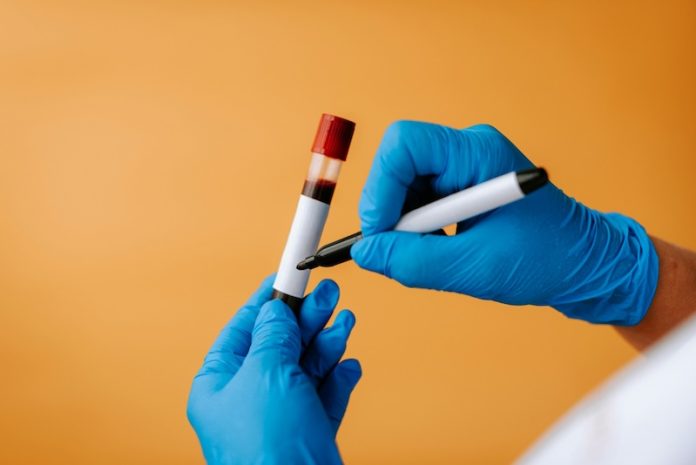
A new study suggests that a simple blood test could help doctors quickly determine whether a stroke is caused by bleeding or a blood clot, even before the patient reaches the hospital.
The research, presented at the American Stroke Association’s International Stroke Conference 2025, found that measuring levels of a brain protein called glial fibrillary acidic protein (GFAP) in the blood could distinguish between the two main types of strokes with 90–95% accuracy.
Why Is a Quick Stroke Diagnosis Important?
When someone has a stroke, every second counts. The longer it takes to diagnose and treat a stroke, the more brain damage occurs, which can lead to severe disability or death. However, before starting treatment, doctors must determine what type of stroke the patient is experiencing:
- Ischemic stroke (caused by a blood clot) needs clot-busting drugs or surgery to remove the blockage.
- Hemorrhagic stroke (caused by bleeding in the brain) requires lowering blood pressure and reversing any blood-thinning medications.
Currently, stroke diagnosis relies on brain imaging, such as CT or MRI scans, but these tests can take hours to complete as patients are transported, stabilized, and scanned. A faster diagnostic tool could help doctors start treatment immediately, potentially saving lives.
GFAP: A Possible Breakthrough for Stroke Diagnosis
Researchers led by Dr. Love-Preet Kalra, a neurology resident at RKH Hospital Klinikum Ludwigsburg, Germany, tested whether GFAP could be used as an early marker for stroke diagnosis. GFAP is a protein released into the blood when brain cells are damaged and is already used to assess traumatic brain injuries.
Study Findings
The study included 353 stroke patients (average age 75, 47% women) who arrived at the emergency room within six hours of symptom onset. Before reaching the hospital, paramedics collected blood samples from the patients. Later, brain scans confirmed that:
- 76 patients had hemorrhagic (bleeding) strokes
- 258 had ischemic (clot-caused) strokes
- 19 had conditions that mimicked strokes, such as seizures or migraines
When researchers compared GFAP levels in the blood, they found:
- GFAP levels were almost seven times higher in bleeding strokes than in clot-caused strokes (208 vs. 30 pg/mL).
- GFAP levels were more than four times higher in bleeding strokes than in stroke mimics (208 vs. 48 pg/mL).
- If GFAP levels were below 30 pg/mL, doctors could confidently rule out a bleeding stroke.
- Using age-specific cut-off points, the test could correctly identify 90–95% of bleeding strokes.
- Patients on blood thinners had even higher GFAP levels, making the test particularly useful for detecting high-risk hemorrhagic strokes.
What This Means for Stroke Treatment
If larger studies confirm these results, GFAP testing could revolutionize stroke care by allowing paramedics to start life-saving treatments before the patient even reaches the hospital.
Dr. Kalra explained, “Treatment to lower blood pressure and reverse blood-thinning medications could be performed in the prehospital setting, leading to a huge change in clinical practice.”
In the future, even clot-busting drugs or blood thinners could potentially be administered in the ambulance, speeding up critical stroke care.
Challenges and Limitations
Despite the promising results, there are some challenges to implementing GFAP testing in routine emergency care:
- A centrifugation step is required (separating blood components), which may slow down the test in emergency settings.
- GFAP levels naturally increase with age, making it harder to diagnose small bleeding strokes in elderly patients.
- Emergency services currently lack portable GFAP testing devices, meaning ambulances and paramedics do not yet have access to this test.
Dr. Louise D. McCullough, a stroke expert at UTHealth Neurosciences in Houston, noted, “For this test to be effective, both the patient’s blood and the GFAP test must be available as a ‘point-of-care’ test in the field.”
Review and Future Implications
This study reinforces the importance of early stroke diagnosis and highlights GFAP as a potential game-changer for stroke treatment. While current diagnosis depends on time-consuming brain imaging, a rapid blood test could allow doctors to:
- Start treatment sooner, preventing further brain damage
- Reduce delays in emergency rooms, improving patient outcomes
- Lower stroke-related disability and death rates
However, before this test becomes a standard stroke assessment tool, larger studies are needed to confirm its reliability across different patient populations. If proven effective, GFAP testing could become a routine prehospital diagnostic tool, allowing stroke patients to receive life-saving treatment faster than ever before.
If you care about heart health, please read studies that yogurt may help lower the death risks in heart disease, and coconut sugar could help reduce artery stiffness.
For more information about health, please see recent studies that Vitamin D deficiency can increase heart disease risk, and results showing vitamin B6 linked to lower death risk in heart disease.
Copyright © 2025 Knowridge Science Report. All rights reserved.



